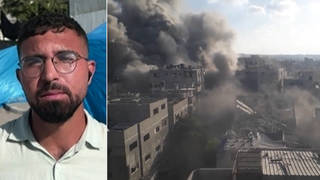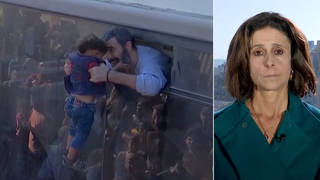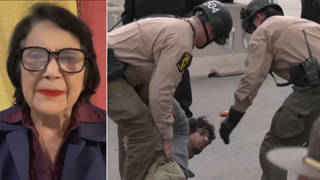
Topics
Guests
- Erin Rosareporter for the Colorado Independent, an online daily. Her recent articles include “Colorado 'Fusion Center' to Step Up Intelligence Gathering During DNC”, “Military to Commandeer Campus for DNC Operations”, “Colorado National Guard Plans to Rent 500+ Hotel Rooms for DNC”
- Mike GermanNational Security Policy Counsel for the American Civil Liberties Union. He was an FBI agent specializing in domestic counterterrorism from 1988 to 2004. He is co-author of the ACLU’s report “What’s Wrong with Fusion Centers”
- Eileen Clancyfounder of I-Witness Video”
Federal and state law enforcement officials in Colorado plan to increase intelligence operations during the Democratic National Convention in Denver and run a fusion center, where intelligence analysts will collect and analyze reports of suspicious activity. Civil rights advocates fear the fusion center could enable unwarranted spying on protesters exercising their First Amendment rights at the convention. [includes rush transcript]
Transcript
SHARIF ABDEL KOUDDOUS: And as we continue to look at surveillance and the conventions, we turn now to a new story out of Denver. Federal and state law enforcement officials in Colorado plan to increase intelligence operations during the Democratic National Convention in Denver and run a fusion center, where intelligence analysts will collect and analyze reports of suspicious activity.
The Colorado Independent reports the military will also be sharing intelligence information and providing support through US Northern Command, a unit created in 2002 for homeland defense. Civil rights advocates fear the fusion center could enable unwarranted spying on protesters exercising their First Amendment rights at the convention.
We’re joined now by three guests. Erin Rosa is a reporter for the Colorado Independent, an online daily. She broke the story on the role of Northern Command at the convention. She joins us from Denver.
ERIN ROSA: Thanks. It’s great to be here.
SHARIF ABDEL KOUDDOUS: Mike German is the National Security Policy Counsel for the American Civil Liberties Union. He was an FBI agent specializing in domestic counterterrorism from 1988 to 2004. He joins us from Washington, D.C.
And Eileen Clancy is still with us, the founder of I-Witness Video.
Erin Rosa, let’s begin with you. You’re the reporter for the Colorado Independent who first broke many of these stories about the fusion centers that are being planned for Colorado for the upcoming DNC. Can you talk about what are the plans that the government is making and who exactly is going to be doing this surveillance?
ERIN ROSA: OK. Well, to start off with, what we would probably need to do is define what a fusion center actually is. And basically, they’re centers meant to facilitate communications between federal, state and local law enforcement agencies to share information about, quote-unquote, “suspicious activities,” which can include taking pictures or taking notes. The definition is very broad when it’s defined by them.
And essentially, what the Colorado Independent has found out is that this fusion center, which is located in Colorado in the Denver metro area, they’re going to be increasing intelligence operations during the convention. And they will be sharing information with the US Secret Service, the Federal Bureau of Investigation and the Northern Command, which is actually stationed about approximately seventy miles from Denver.
SHARIF ABDEL KOUDDOUS: And, Erin Rosa, how is US Northern Command involved?
ERIN ROSA: Well, we have confirmed that US Northern Command has been asked by the Secret Service to help out with convention security, which is bringing in a military entity into the convention security process. They will be providing materials, such as security guard — excuse me, security dogs, to the US Secret Service. They haven’t elaborated on everything they’re going to be assisting with. They will also be sharing information with the fusion center, as they have done so in the past, intermittently, when it’s warranted.
ANJALI KAMAT: I’d like to turn to Mike German, National Security Policy Counsel for the American Civil Liberties Union. Mike German, you did a report — you co-authored a report in November 2007 about fusion centers, and you just put up an update to it earlier in the week. Can you talk about your concerns?
MIKE GERMAN: Sure. Our report in November was basically hoping to be a warning signal, that we saw some problems with these centers, these fusion centers, that were being created all over the country. And really, what they are is a collaborative effort between not just state, local and federal law enforcement, but also, as in Colorado, involving the military, private sector companies and other non-law enforcement government agencies. So it really is breaking down all the arm’s-length relationships and putting all these people together in an environment where it’s unclear who is actually in charge and whose rules apply to the information that’s being collected and shared and distributed through these fusion centers. And particularly where the military and private entities were involved, it seemed that it was inappropriate to incorporate them into what is essentially a law enforcement function. And in fact, there are some pretty longstanding laws that are supposed to prevent that sort of military intervention in law enforcement activities.
So, the November report was supposed to just, you know, put up a warning to let people out in the communities around the country know about it, but also to let state legislators and members of Congress know that there are some problems with this lack of — or ambiguity over who’s in control, because we were afraid that would lead to problems. And, of course, the excessive secrecy that was surrounding these centers, it was hard to know exactly what they were doing and under whose authority they were operating.
In the six months since, there have been so many news stories that have come out showing abuses that center around or are associated with these centers that we thought we’d better update the report to let people know that this isn’t just a hypothetical concern, that there are actually misconduct going on now that needs to be addressed.
ANJALI KAMAT: Mike German, I wanted to ask you to lay out how the fusion centers are a development from previous intelligence-gathering mechanisms since 9/11. You had the TIPS program. You had the Joint Terrorism Task Force. Where do fusion centers fit in?
MIKE GERMAN: Well, it’s interesting. Fusion centers sort of started organically around the country. It seemed like state and local law enforcement were frustrated with the Joint Terrorism Task Force’s ability to break down the classification rules and actually share information with them, so they started creating their own networks to share state police information. And once the federal government saw those and saw them working, they started pouring in resources and sort of changing the nature of them to really encourage them to — state and local law enforcement authorities and these other entities in the fusion centers — to become intelligence collectors for the intelligence community, the federal intelligence community.
And as you said, those earlier programs — TIPS and MATRIX and those kind of programs — were centralized within the federal government, so it was easy for the civil liberties community and the privacy community to focus their efforts and get those things stopped. This is much more difficult, because the federal government is saying, no, these aren’t federal entities, they’re state entities. So, you know, instead of one focal point, there have to be fifty, and each one is actually different, because they did grow up organically. And not all of them are engaged in the same sorts of behavior, so it’s very difficult to generalize about what’s going on. So it’s really incumbent upon, you know, every local community to start asking questions of their local police departments and their local government officials to find out exactly what’s happening in their neighborhood.
And, you know, as your earlier stories today showed, where people think that nobody is watching, they’ll do some really, you know, terrible things that aren’t justified under any legal system. And in these centers, it appears that nobody is watching.
And there’s one story that we highlight in our report that happened in Los Angeles, where, after 9/11, the very first fusion center, the law — or, I’m sorry, Los Angeles County Terrorism Early Warning Center, the co-founder of that center contacted the US Northern Command after 9/11 and started a conspiracy to steal Military Intelligence records that later involved at least seven law enforcement officers and military reservists in this theft scheme, stealing military surveillance records apparently pertaining to southern California mosques. And, you know, it’s unclear why the military has those records in the first place, but the fact that this group could operate for five years stealing these highly classified records sort of is, you know, the perfect storm of the issues that we brought up in our earlier report, that this is a real problem that needs to be addressed, because it wasn’t any internal controls that discovered this theft ring. It was actually discovered by accident, when the Marine Corps down in Camp Pendleton was searching for stolen Iraq war booty and searched a storage locker here in Manassas, Virginia and found not just the stolen Iraq war trophies, but also boxes of highly classified records. And that’s how this ring was stopped after five years.
SHARIF ABDEL KOUDDOUS: Well, we have to break. We’ll continue this discussion when we come back. Mike German is the National Security Policy Counsel for the American Civil Liberties Union. We’re also speaking with Erin Rosa, the reporter for the Colorado Independent, and Eileen Clancy, the founder of I-Witness Video. Stay with us.
[break]
SHARIF ABDEL KOUDDOUS: We’re talking about fusion centers and intelligence gathering at the upcoming DNC and RNC. We’re talking with Mike German, the National Security Policy Counsel for the American Civil Liberties Union; Eileen Clancy is the founder of I-Witness Video; and Erin Rosa, a reporter for the Colorado Independent.
Erin, you have this amazing story just recently in the publication talking about how the Colorado Army National Guard is renting out hundreds of rooms in Denver for the convention. Can you talk about that?
ERIN ROSA: Well, it would appear, from records from a federal database, that the Colorado Army National Guard is apparently constructing a makeshift barracks in the far east region of the city that will be on-call. They’re not saying what the purpose is for nearly 400 people to be stationed in this private university. They’re actually going to be stationed at Johnson & Wales University in the eastern region of the city, you know, more than 400 troops in that one area. They rented more than 500 rooms across the city. And they’re not saying what the purpose will be for, but they have confirmed that it will be all Colorado National Guard personnel.
ANJALI KAMAT: Eileen Clancy, I want to turn to you. Can you talk a little bit about the RNC and the documents you’ve obtained from the 2004 RNC?
EILEEN CLANCY: Yeah. There’s a document that has been made public before that was compiled by the Secret Service, in charge of the Republican convention in New York City. And the Secret Service is the lead agency for these national special security events, like all the presidential conventions. And the document is a best-practices-and-lessons-learned document that was presented a couple of months after the 2004 convention closed. And it’s a PowerPoint presentation, so we don’t have a lot of details; it’s all bullet points.
But what it shows is it shows the structure of the committees that, you know, looked after this kind of part of the convention business. And there’s a subcommittee of a law enforcement and public safety group that’s on intelligence and counterterrorism. I’m going to just take a look at the page. And the objective of this subcommittee was to obtain, assess and share information about individuals and groups who might pose a threat, to protect these designated venues and/or the RNC itself.
But what’s fascinating about it, besides we know that the FBI and the police department and the Secret Service were involved, the members of this committee are — include the CIA, the Department of Defense, DIA, which is the Defense Intelligence Agency, and it also includes something called TTIC, which is the Terrorist Threat — I think it’s Integration Center, if I’m getting that right, or maybe it’s “Information.” And what happens for these national security special events like the conventions is that they make their own fusion center just for this event. It’s like an ad hoc special project, kind of like what we’re doing but with a lot more money and a lot more power.
And what it says here is that through this intelligence fusion center and the Joint Terrorist Task Force fusion center, which is yet another fusion center that was put in place, this subcommittee achieved its primary objective of sharing threat — and then it says, “demonstration intelligence” among the subcommittee members. So, the point here is that the CIA, the Defense Department and the upper reaches of the federal — what they call the intelligence community, believe it or not, they are having access to intelligence, what they call “intelligence” about demonstrations. I might just call it information, but they seem to need to share it. Now, I don’t even know if it’s legal for the CIA to be involved in domestically to this extent, but there’s the Department of Defense.
This document was presented by Steven G. Hughes, who was the agent in charge of the 2004 convention, and happens to be the agent in charge of the Democratic convention in Denver this year.
SHARIF ABDEL KOUDDOUS: And you — the government using the public airwaves for surveillance tests, you have information on that, as well.
EILEEN CLANCY: Well, what we saw during the Republican convention in New York was that there was an experimental project, a pilot project, that took spectrum, digital spectrum that’s owned by WNET, Channel 13, in New York City, the PBS sort of flagship in New York City, and what they did was they routed a special test for two-way video, so that, say, a police officer could have a camera where he could be videotaping something, and it would go — would be transmitted through the Empire State Building, the transmitter on top of the Empire State Building, and then through a Department of Defense satellite to a server in Virginia that was a military server, and also that they could pass information sort of back and forth. And the thing about this was it’s non-line-of-sight, so it was a special kind of technology where the buildings wouldn’t get in the way. And that’s an example of how the federal government and local governments use the conventions basically as an excuse to make a laboratory to play with these toys and set up surveillance processes that we’re going to see sometime in the future.
You saw this in New York City, where they take — they took the money to make an — from the conventions, the federal budget that was given to the city to make an emergency operations center, and they call it a “situations room,” and they put in all these video apparatus. Similarly, last year, a deputy chief in Denver testified to a House subcommittee about fusion centers and how they were going to use the convention in Denver as an opportunity to basically lay a structure for what they called a “super fusion center.” And so, they’re going to take some of that $50 million that Denver is going to get and — apparently, and going to be using it to build a more permanent and more powerful surveillance apparatus for Colorado.
ANJALI KAMAT: I want to bring Mike German back into the discussion. Mike German, you’re a former FBI special agent and terrorism analyst. Can you talk about what Eileen Clancy just talked about, the — what is the legality of the CIA and the military being involved in domestic operations?
MIKE GERMAN: Well, you know, as I said, it’s very ambiguous. And, you know, this isn’t just something that’s happening in the future. It’s happening in the future in Colorado, but it’s actually going on now elsewhere. In January, the Director of National Intelligence issued functional standards for suspicious activity reporting to get all the police departments and all the different agencies and elements involved in the fusion centers to report suspicious activity in a standardized format, for the purpose of uploading this information into the information sharing environment, so the information could be shared easily among the various fusion centers, but also with the intelligence community. So, basically, what this system is doing is creating a — basically deputizing every state and local law enforcement officer to be an intelligence collector for the intelligence community. This information is being directly, you know, created in a way so it’s accessible by these intelligence agencies.
And, you know, part of the problem is that it’s unclear what the rules are. And, you know, when you see something like the CIA participating on these panels and the military involved, it’s unclear who’s actually in charge, and that’s really a large part of the problem that we’re seeing as these things are moving forward, because the information is already being collected.
Right after the DNI put out those standards, the Los Angeles Police Department issued an order compelling their officers to report criminal and non-criminal suspicious behavior that can be indicative of terrorism, and they listed sixty-five behaviors. And Erin mentioned some of them, but one warning I’ll put out there, because of the early part of this story, one of the precursor behaviors to terrorism that’s identified in the order is taking video. And we put in our report a couple of instances where people taking video were stopped by police officers simply for taking pictures or video. And in some cases, particularly where they’re taking photographs or video of police, it actually resulted in arrests. So, you know, when you’re out there with your video camera, a police officer reading this report may say that’s a precursor behavior to terrorism and, you know, get involved in what you’re doing.
SHARIF ABDEL KOUDDOUS: And, Erin Rosa, you’ve written about how, even if someone has reported the suspicious activity and it’s dismissed afterwards, that activity is still recorded in a database and remains there.
ERIN ROSA: Yes, and that’s probably one of the most disturbing aspects about this, is that officials with the fusion center here have confirmed that even if they receive a report of suspicious activity, if it merits investigation, they will forward it to the appropriate agency to investigate. The fusion center itself does not do investigations. However, even if a suspicious — excuse me, even if activity does not merit an investigation, they make a log of that, and they hold that data for an indefinite period of time. They don’t have any kind of sunset deadlines on destroying data after a period of time, even though officials with the fusion center have also said that they don’t really need the data after two months.
ANJALI KAMAT: Mike —-
MIKE GERMAN: And I might add -—
ANJALI KAMAT: Go ahead.
MIKE GERMAN: I might add to that that the Department of Justice, Department of Homeland Security and Major City Chiefs Association issued a report, following the LAPD order, adopting that procedure and recommending it for every other city. And there’s a schematic in that that shows how the suspicious activity report flows. There’s a federal law that says a law enforcement intelligence database cannot contain personally identifiable information unless there’s a reasonable suspicion of criminal activity. But the schematic clearly shows that even before that decision is made of whether there’s reasonable suspicion and the police department itself can keep the information, they will have already reported it to the Joint Terrorism Task Force and to the fusion center. And that’s sort of this shell game, where the information goes, and that it can be placed sort of in this database, separate from the police database, so they can remain compliant with the law, but they know that they have routine access to the information at the fusion center, so it’s sort of like just putting it in a different drawer and pretending that it’s not theirs anymore.
ANJALI KAMAT: Mike German, we just have a minute left —-
ERIN ROSA: Yeah, and I also -—
ANJALI KAMAT: If I can just ask you one question about your response to recent revelations that the Maryland State Police have been spying on activists against the death penalty and antiwar activists.
MIKE GERMAN: Absolutely. And that’s a perfect example where the Maryland State Police, you know, sort of taking this encouragement from the federal government, expand beyond what normal police function is, beyond normal law enforcement functions, and start becoming intelligence collectors against protest groups. And the reports that we obtained from them make clear that there was no indication of any sort of criminal activity — quite the opposite, that they were peaceful at all times. And yet, that investigation went on for fourteen months, and these reports were uploaded into a federal database. Now, the Department of Homeland Security and the fusion center are now claiming they never access that information, but it was sitting there in a database that was accessible to them at any time. So, really, it’s a semantic difference whether they actually did, because they could have. And, you know, the problem is, when all these agencies are authorized to go out and start collecting this information and putting it in areas where it’s accessible by the intelligence community, it’s a very dangerous proposition for our democracy.
ANJALI KAMAT: We’ll have to leave it there. I want to thank you all for being with us. Eileen Clancy is the founder of I-Witness Video, joining us here in New York. Erin Rosa is a reporter for the Colorado Independent. And Mike German is the National Security Policy Counsel for the ACLU.












Media Options